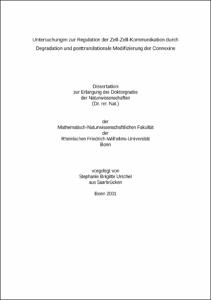Urschel, Stephanie Brigitte: Untersuchungen zur Regulation der Zell-Zell-Kommunikation durch Degradation und posttranslationale Modifizierung der Connexine. - Bonn, 2001. - Dissertation, Rheinische Friedrich-Wilhelms-Universität Bonn.
Online-Ausgabe in bonndoc: https://nbn-resolving.org/urn:nbn:de:hbz:5n-01747
Online-Ausgabe in bonndoc: https://nbn-resolving.org/urn:nbn:de:hbz:5n-01747
@phdthesis{handle:20.500.11811/1727,
urn: https://nbn-resolving.org/urn:nbn:de:hbz:5n-01747,
author = {{Stephanie Brigitte Urschel}},
title = {Untersuchungen zur Regulation der Zell-Zell-Kommunikation durch Degradation und posttranslationale Modifizierung der Connexine},
school = {Rheinische Friedrich-Wilhelms-Universität Bonn},
year = 2001,
note = {Communication through Gap Junctions could be regulated by multiple mechanisms. In this work the role of degradation of connexins as a mean to modulate communication was investigated. Furthermore the influence of phosphorylation of connexins on communication was analysed.
Regulation of communication by degradation of connexins implies that cells have to be able to modulate the half-live of connexins.
It was shown that the expression pattern of connexins influences their degradation rate. At least some connexins could stabilise others at protein-level. The half-life of connexin26 (cx26) could be prolonged by co-expression of connexin32 (cx32) and connexin45 (cx45) could be stabilised by co-expression of connexin43 (cx43).
Degradation of cx26 and cx32 involves both proteasomes and lysosomes. The use of either lysomal or proteasomal degradation-inhibitors results in an increased coupling of cx26-expressing cells. Inhibition of lysosomes but not proteasomes increased the coupling of cx32-expressing cells. These results showed that communication through gap junctions could be up-regulated by a prolonged degradation-rate.
Experiments with 31p-labelled cells revealed that the different influence of degradations-inhibitors of coupling via cx32-expressing cells was caused by dephosphorylation of cx32 in cells where lysosomal activity was blocked.
A typical feature of glioma-cells is reduced coupling caused by low amounts of cx43 compared to astrocytes. Using two glioma cell-lines it was demonstrated that not only the amount of expressed connexin but also the phosphorylation-pattern influences cell-cell-commnication. Both cells-lines express cx43 at a similar level but showed great differences in coupling. Analysation of 31p-labelled cells showed that the phosphorylation-patterns of the expressed cx43 in both cells largely diverge from each other. This implies that the different phosporylated isoforms of cx43 cause the varying coupling.},
url = {https://hdl.handle.net/20.500.11811/1727}
}
urn: https://nbn-resolving.org/urn:nbn:de:hbz:5n-01747,
author = {{Stephanie Brigitte Urschel}},
title = {Untersuchungen zur Regulation der Zell-Zell-Kommunikation durch Degradation und posttranslationale Modifizierung der Connexine},
school = {Rheinische Friedrich-Wilhelms-Universität Bonn},
year = 2001,
note = {Communication through Gap Junctions could be regulated by multiple mechanisms. In this work the role of degradation of connexins as a mean to modulate communication was investigated. Furthermore the influence of phosphorylation of connexins on communication was analysed.
Regulation of communication by degradation of connexins implies that cells have to be able to modulate the half-live of connexins.
It was shown that the expression pattern of connexins influences their degradation rate. At least some connexins could stabilise others at protein-level. The half-life of connexin26 (cx26) could be prolonged by co-expression of connexin32 (cx32) and connexin45 (cx45) could be stabilised by co-expression of connexin43 (cx43).
Degradation of cx26 and cx32 involves both proteasomes and lysosomes. The use of either lysomal or proteasomal degradation-inhibitors results in an increased coupling of cx26-expressing cells. Inhibition of lysosomes but not proteasomes increased the coupling of cx32-expressing cells. These results showed that communication through gap junctions could be up-regulated by a prolonged degradation-rate.
Experiments with 31p-labelled cells revealed that the different influence of degradations-inhibitors of coupling via cx32-expressing cells was caused by dephosphorylation of cx32 in cells where lysosomal activity was blocked.
A typical feature of glioma-cells is reduced coupling caused by low amounts of cx43 compared to astrocytes. Using two glioma cell-lines it was demonstrated that not only the amount of expressed connexin but also the phosphorylation-pattern influences cell-cell-commnication. Both cells-lines express cx43 at a similar level but showed great differences in coupling. Analysation of 31p-labelled cells showed that the phosphorylation-patterns of the expressed cx43 in both cells largely diverge from each other. This implies that the different phosporylated isoforms of cx43 cause the varying coupling.},
url = {https://hdl.handle.net/20.500.11811/1727}
}






